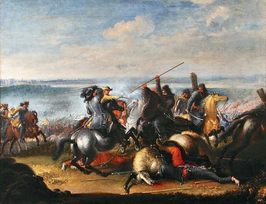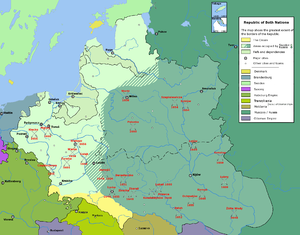Deluge (history)
This article needs additional citations for verification. (July 2006) |
In the history of Poland and Lithuania, the Deluge (Polish: Potop, in full in Polish: Potop Szwedzki [Swedish Deluge]) commonly refers to a series of wars in the mid-to-late seventeenth century which left the Polish-Lithuanian Commonwealth in ruins. Template:TOCnestright
In a strict sense, "The Deluge" refers to the Swedish invasion and occupation of the Poland-Lithuania from 1655 to 1660; in a general sense it applies to the series of misfortunes beginning with the Khmelnytskyi Uprising in 1648 and ending as late as 1667.
Before the Deluge, the Polish-Lithuanian Commonwealth formed — in terms of territory — the largest state in Europe (discounting the Holy Roman Empire, a fragmented, fractious non-state). The Commonwealth had a strong army and a large population, giving it a solid reputation as a regional power — and many[who?] would argue as a great power as well, for while it did not possess a strong navy to project power over the oceans, as a geohistoric polity it dominated the smaller states in east/central Europe — only the territorial extent of the Ottoman empire or the combined European dominions of the Spanish empire rivaled it in size and population. But during the wars the Commonwealth lost an estimated one-third of its population (relatively higher losses than during World War II) as well as its status as a great power.[5][failed verification]
Historical events
The misfortunes began in 1648 when the Ruthenian feudal lord Bohdan Khmelnytsky (also known as "Bohdan Chmielnicki") led a popular uprising of Dnieper Cossacks and Ukrainian peasants discontented with the rule of Polish magnates.
Although the rebellion, after much destruction, itself ended at the Battle of Berestechko (1651), the Russians used it as a pretext for invading the eastern half of Poland-Lithuania in 1654. The Swedish Empire, which had a long-standing dynastic feud with the Commonwealth and other issues in the Baltic region, also opportunistically invaded and occupied the remaining half of the country in 1655.
Two Polish-Lithuanian noble princes, Janusz Radziwiłł and Bogusław Radziwiłł, subsequently introduced internal disaffection and dissension into the Commonwealth's troubles and began negotiations with the Swedish king Charles X Gustav of Sweden aimed at breaking up the Commonwealth and the Polish-Lithuanian union. They signed the Kėdainiai Treaty, which envisaged the Radziwiłłs ruling over two Duchies carved out from the lands of the Grand Duchy of Lithuania under Swedish vassalage (the Union of Kėdainiai).
The Polish-Lithuanian King John II Casimir lacked support amongst the nobility (szlachta) due to his sympathies with absolutist Austria and his open contempt for the culture of the nobility (see Sarmatism). Earlier, in 1643, John Casimir had become a member of the Jesuits and had received the title of Cardinal. Nevertheless, in December 1646 John Casimir had returned to Poland and, in October 1647, resigned his position of Cardinal to stand in elections for the Polish throne. He succeeded to the throne in 1648. However, some of the nobility regarded Charles Gustav (King of Sweden and John Casimir's cousin) as the legitimate heir to the Polish-Lithuanian throne. Many members of the Polish nobility (szlachta), including Deputy Chancellor of the Crown Hieronim Radziejowski and Grand Treasurer of the Crown Bogusław Leszczyński, regarded John II Casimir of Poland as a weak king or as a Jesuit-King and for this and other reasons, they encouraged Charles Gustav to claim the Polish crown.
When the Swedish armies first invaded Poland, the Voivod of Poznań, Krzysztof Opaliński, surrendered Great Poland to Charles Gustav. Other areas also surrendered in rapid succession. Almost the whole country followed suit, with the Swedes entering Warsaw unopposed in August, 1655 and John Casimir fleeing to Silesia. However several places still resisted, most remarkably and symbolically, the monastery at Jasna Góra. Led by The Grand Prior Augustyn Kordecki, the garrison of this sanctuary-fortress of Poland held off its enemies (November 1655 to January 1656). The siege and defense of Jasna Góra galvanized Polish resistance to the Swedes. In December 1655 the Tyszowce Confederation formed in support of the exiled John Casimir.
Spontaneous[citation needed] uprisings started all over the country, attacking the dispersed occupation forces — who, in their turn, retaliated. The uprisings soon merged under the leadership of Polish military leader Stefan Czarniecki and Grand Hetman of Lithuania Jan Paweł Sapieha, who started organized counterattacks in order to eliminate those loyal to Charles Gustav. In the end, John II Casimir's supporters crowned him in Lwów Cathedral in 1656 (Lwów Oath). The Commonwealth forces finally drove back the Swedes in 1657.
The Commonwealth also defeated forces from Transylvania and Brandenburg-Prussia, but the Duchy of Prussia gained formal Polish recognition of its independence outside of the Polish state (Treaty of Wehlau, 1657).

With the Treaty of Hadiach on September 16, 1658, the Polish Crown elevated the Cossacks and Ruthenians to a position equal to that of Poland and Lithuania in the Polish-Lithuanian Union, and in fact transformed the Polish-Lithuanian Commonwealth into a Polish-Lithuanian-Ruthenian Commonwealth (Polish: Rzeczpospolita Trojga Narodów, "Commonwealth of Three Nations"). Supported by Cossack Ataman Ivan Vyhovsky and the starshyna, the treaty aimed to change the face of Eastern Europe. However, the terms of the treaty never went into full operation. Russia refused to recognize Hadiach, and maintained its claims to Ukraine.
The War for Ukraine (1654-1677) ended with the Treaty of Andrusovo of 13 January, 1667. (Poland-Lithuania profited from Turkish intervention in the Russo-Turkish War (1676–1681) due to Ottoman links with the Crimea). The peace settlement gave Moscow control over the so called Left-bank Ukraine with the Commonwealth retaining Right-bank Ukraine. While initially the agreement stipulated that Russia would return Left-bank Ukraine to the Commonwealth in twenty years, the division became permanent with the Eternal Peace Treaty of 1686.
The Deluge brought to an end the era of Polish religious tolerance: mostly non-Catholic invaders antagonised the mostly Catholic Poles. The expulsion of the Protestant Polish brethren in 1658 became but one example of increasing intolerance. During the Deluge, many thousands of Polish Jews also fell victim to pogroms initiated by rebelling Cossacks.

The Deluge in fiction
Henryk Sienkiewicz describes The Deluge in his novel Potop.
James Michener describes The Deluge in his novel Poland.
Jerzy Hoffman directed the film The Deluge (Potop) in 1974, a classic historical work. It starred Daniel Olbrychski as Andrzej Kmicic, a patriot who valiantly fought against the Swedish invasion. The film received a nomination for an Oscar in 1974, but lost to the Italian film Amarcord.
Notes
- ^ Ervin Liptai: Military history of Hungary, Zrínyi Military Publisher, 1985. ISBN 9633263379
- ^ Ervin Liptai: Military history of Hungary, Zrínyi Military Publisher, 1985. ISBN 9633263379
- ^ László Markó: Lordships of the Hungarian State, Magyar Könyvklub Publisher, 2000. ISBN 963 547 085 1
- ^ László Markó: Lordships of the Hungarian State, Magyar Könyvklub Publisher, 2000. ISBN 963 547 085 1
- ^ About Poland
See also
- Nobles' Democracy
- Northern Wars
- Treaty of Hadiach
- Treaty of Oliva
- Kostka-Napierski Uprising
- The Deluge (novel)
- Tatar invasions
External links
- Potop at IMDb
- Map of area occupied by Transylvania in 1657
- Articles needing additional references from July 2006
- 1650s
- 17th-century conflicts
- Invasions
- Wars involving Poland
- Wars involving Sweden
- Cossack uprisings
- Guerrilla wars
- History of Poland (1569–1795)
- Poland–Sweden relations
- History of Lithuania (1569–1795)
- Warfare of the Early Modern era
- Black Madonna of Częstochowa
- 17th century in Lithuania




